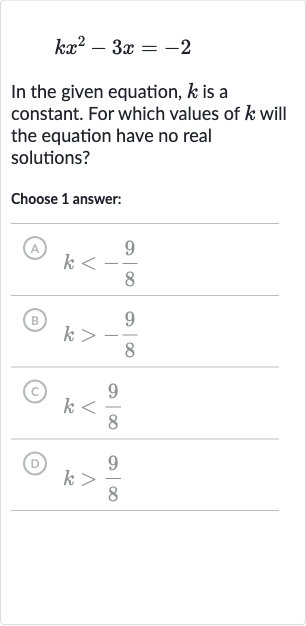Full solution
Q. In the given equation, is a constant. For which values of will the equation have no real solutions?Choose answer:(A) (B) (C) (D)
- Rewrite in Standard Form: First, we need to rewrite the equation in standard quadratic form, which is . We do this by adding to both sides of the equation.
- Use Discriminant: Next, we determine the conditions for which a quadratic equation has no real solutions by using the discriminant. The discriminant of a quadratic equation is given by . If the discriminant is less than zero, the equation has no real solutions.For our equation, , , and . So the discriminant is .
- Calculate Discriminant: Now, we calculate the discriminant:Discriminant = .
- Set Up Inequality: For the equation to have no real solutions, the discriminant must be less than zero: 9 - 8k < 0.
- Solve for : We solve the inequality for :-8k < -9k > \frac{9}{8}.
- Final Answer: The inequality k > \frac{9}{8} means that for any value of greater than , the equation will have no real solutions. Therefore, the correct answer is:(D) k > \frac{9}{8}.
More problems from Is (x, y) a solution to the system of linear inequalities?
QuestionGet tutor help
QuestionGet tutor help
QuestionGet tutor help
QuestionGet tutor help
QuestionGet tutor help
QuestionGet tutor help
QuestionGet tutor help
QuestionGet tutor help

